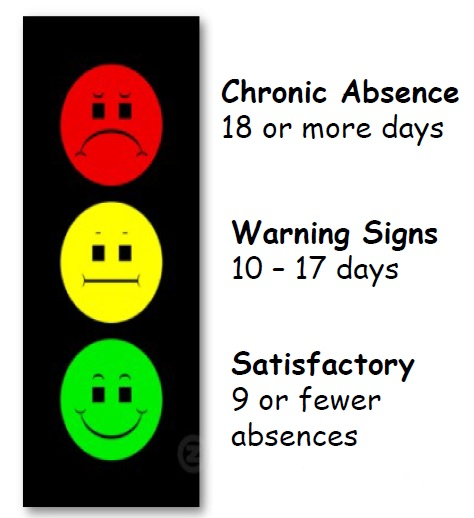Why Attendance Matters

Refer to the Attendance Policy for specific information regarding attendance requirements.
Many parents are not aware of how quickly absences add up to academic trouble.
Chronic Absence 18 or more days
Warning Signs 10 –17 days
Satisfactory 9 or fewer absences
Excused and unexcused absences result in too much time lost in the classroom.
Many children miss 10% of a school year – that is almost a month per school year! (Chronic Absenteeism in the Nation's Schools, United States Department of Education. (2019, January). Department of Education, United States of America. https://www2.ed.gov/datastory/chronicabsenteeism.html)
Parents underestimate the number of year-end absences. (Rogers, T. & Feller, A. (2018). Reducing student absences at scale by targeting parents’ misbeliefs. Nature Human Behaviour. Harvard University. https://scholar.harvard.edu/files/todd_rogers/files/rogers_sdp_-_final.pdf)
60% of parents said their child was absent an average of 2+ days a month, but not 10+ days a year. (How Parents Really Feel About Attendance. (2016, February 18). Attendance Works. https://www.attendanceworks.org/parents-really-feel-attendance/)
If a child is absent an average of 2+ days a month, then they are absent far more than 10+ days a year.
One in 10 kindergarten and 1st grade students nationally are chronically absent. (Chang, Hedy and Romero, Mariajose. Present, Engaged and Accounted For: The Critical Importance of Addressing Chronic Absence in the Early Grades, National Center for Children in Poverty, New York, NY, September 2008.)
Children who are chronically absent in kindergarten and first grade are less likely to read on grade level by the third grade. (Source: healthychildren.org)
Our nation is facing a crisis in early literacy: fully two-thirds of U.S. fourth graders are not reading proficiently, national assessments show. The numbers are even more dire for students from low-income families: 80 percent of them haven’t reached proficiency.
A 2011 California study connected early attendance with third-grade reading proficiency, which is considered a key indicator of future academic success. Applied Survey Research found that 64 percent of the students with good attendance in kindergarten and first grade scored proficient on the state’s third-grade English language arts test. That compares to 41 percent of students who were chronically absent one of those years. For students chronically absent in both kindergarten and first grade, only 17 percent scored proficient. (Attendance in Early Elementary Grades: Association with Student Characteristics, School Readiness and Third Grade Outcomes, Applied Survey Research, May 2011.)
Over 2/3 of the U.S. fourth grade students are NOT reading at grade level! (Since Pandemic's Start, 42 States See Rise in Fourth-Graders Below Reading Proficiency. (2022, November 4). The Annie E Casey Foundation. https://www.aecf.org/blog/fourth-grade-reading-proficiency-2022)
By 6th grade chronic absenteeism is a leading indicator that a student will drop out of high school. (Why Is School Attendance Important? The Effects of Chronic Absenteeism. (2021). American University, Washington D.C. american.edu)
A student who misses 10days is 25% less likely to enroll in college. (Garcia E. and Weiss E. (2018, September 25), Student absenteeism Who misses school and how missing school matters for performance. Economic Policy Institute. https://www.epi.org/publication/student-absenteeism-who-misses-school-and-how-missing-school-matters-for-performance/)
Students who attend school regularly are more likely to graduate and find good jobs. (Source: Hickman, G.P., Bartholomew, M., and Mathwig, J. (2007). The Differential Development Trajectories of Rural High School Dropouts and Graduates: Executive Summary. Phoenix, AZ: The College of Teacher Education and Leadership at the Arizona State University at the West Campus.)
A high school graduate makes $1 million more than a dropout over a lifetime. (Johnston, C. (2011, July 24). Series overview: The cost of dropping out. NPR. https://www.npr.org/2011/07/24/138508517/series-overview-the-cost-of-dropping-out)
